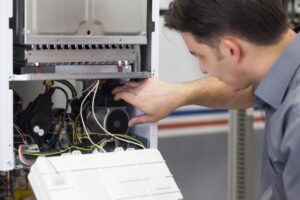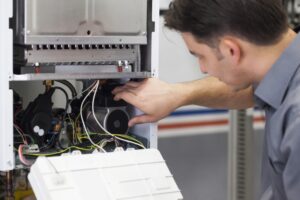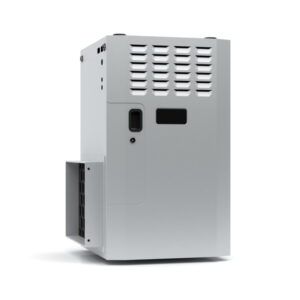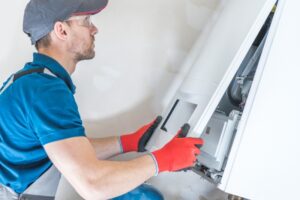 Furnaces require maintenance just like any other heating system, but when you’ve got a gas furnace, there’s one additional aspect you need to consider. Safety is always the first priority, but it’s something you’re going to want to remember each year when you go to turn on your system for the first time, or start investigating a problem.
Furnaces require maintenance just like any other heating system, but when you’ve got a gas furnace, there’s one additional aspect you need to consider. Safety is always the first priority, but it’s something you’re going to want to remember each year when you go to turn on your system for the first time, or start investigating a problem.
Don’t get us wrong, gas furnaces aren’t dangerous. They’re designed with safety measures in place so that they can easily heat your home without problems. And, to make matters better, they’ve got protocols to shut down whenever a safety issue does come up. But things can go wrong, especially after years of neglect and missed maintenance or repairs, and your furnace could start operating unsafely.
That’s why you need to invest in an inspection. This is the furnace service in Boerne, TX that will set things right for the rest of the year.
Continue Reading
Tags: Boerne, furnace service
Posted in Heating | Comments Off on Invest in a Furnace Inspection Today





 It may seem that summer has barely ended. You’re just starting to enjoy all that fall has to offer: football season, family celebrations, and finally a break in the hot weather. But we assure you, no matter how hard you try to ignore it, winter will come. You want to be ready for it when it does get here. And the best thing you can do to prepare is to make sure that your heater will be in good working order for that first cold snap.
It may seem that summer has barely ended. You’re just starting to enjoy all that fall has to offer: football season, family celebrations, and finally a break in the hot weather. But we assure you, no matter how hard you try to ignore it, winter will come. You want to be ready for it when it does get here. And the best thing you can do to prepare is to make sure that your heater will be in good working order for that first cold snap. Finding the optimal temperature for a home is a lot like finding a leprechaun. Sure, you’ve probably heard that it exists, but no matter what you do or how hard you look it seems like you just can’t find it. It seems like every single person has different advice to tell you about their home temperature. Some people “never turn the thermostat lower than 68” while others “never turn it higher than 60.” Isn’t it frustrating?
Finding the optimal temperature for a home is a lot like finding a leprechaun. Sure, you’ve probably heard that it exists, but no matter what you do or how hard you look it seems like you just can’t find it. It seems like every single person has different advice to tell you about their home temperature. Some people “never turn the thermostat lower than 68” while others “never turn it higher than 60.” Isn’t it frustrating? Most of our customers know one big detail about carbon monoxide–that it’s poisonous. As long as you know that carbon monoxide is bad and should never be allowed to exist in your home, then you’re probably fine to continue with life as usual. However, for our more curious customers that want a bit more information as to why carbon monoxide is poisonous, then you’re in the right place.
Most of our customers know one big detail about carbon monoxide–that it’s poisonous. As long as you know that carbon monoxide is bad and should never be allowed to exist in your home, then you’re probably fine to continue with life as usual. However, for our more curious customers that want a bit more information as to why carbon monoxide is poisonous, then you’re in the right place. Furnaces require maintenance just like any other heating system, but when you’ve got a gas furnace, there’s one additional aspect you need to consider. Safety is always the first priority, but it’s something you’re going to want to remember each year when you go to turn on your system for the first time, or start investigating a problem.
Furnaces require maintenance just like any other heating system, but when you’ve got a gas furnace, there’s one additional aspect you need to consider. Safety is always the first priority, but it’s something you’re going to want to remember each year when you go to turn on your system for the first time, or start investigating a problem. Most homes in our area are powered by electricity. With that, most of those homes have heating systems that are also powered by electricity. As the power grid gets upgraded and more sustainable sources of energy start pouring in, we’re likely to see our electric heating systems increase in popularity over the coming years. This is a good thing!
Most homes in our area are powered by electricity. With that, most of those homes have heating systems that are also powered by electricity. As the power grid gets upgraded and more sustainable sources of energy start pouring in, we’re likely to see our electric heating systems increase in popularity over the coming years. This is a good thing! Lots of issues can crop up in a furnace. From electrical problems to ignition issues, to gas leaks or overheating… There’s really no limit to the number of problems a furnace can have. Thankfully, with a licensed professional like the ones on our team by your side, most of those problems can be easily taken care of in a simple repair appointment. Most furnaces only encounter a handful of problems in their lifetimes, so you really don’t need to worry about all of the ones we listed.
Lots of issues can crop up in a furnace. From electrical problems to ignition issues, to gas leaks or overheating… There’s really no limit to the number of problems a furnace can have. Thankfully, with a licensed professional like the ones on our team by your side, most of those problems can be easily taken care of in a simple repair appointment. Most furnaces only encounter a handful of problems in their lifetimes, so you really don’t need to worry about all of the ones we listed.













